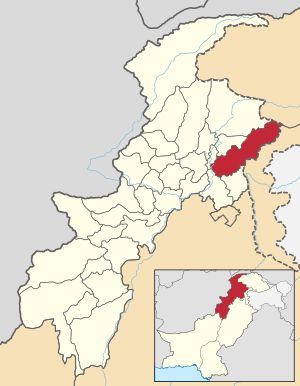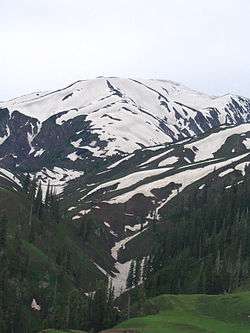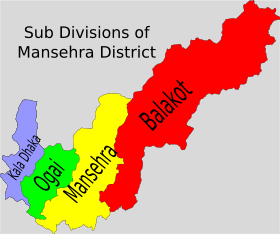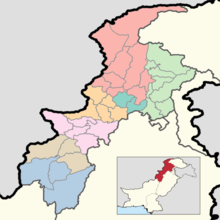Mansehra District
Mansehra District (Pashto: مانسہرہ ولسوالۍ, Urdu: ضِلع مانسہرہ) is a district in Hazara Division of Khyber Pakhtunkhwa province in Pakistan. Mansehra district and town are named after the Sikh Khalsa Army general Mahan Singh Mirpuri, who founded the city. It is an important and popular tourist destination due to the Lulusar-Dudipatsar National Park and Kaghan Valley area being located in the district and the Karakoram Highway passing through the district. It is main gateway to upper valleys of Kaghan, Naran and also to Gilgit-Baltistan and Azad Kashmir.
Mansehra District | |
|---|---|
 Location of Mansehra District (including Torghar District) within Khyber Pakhtunkhwa prior to 2011 | |
| Country | |
| Province | Khyber Pakhtunkhwa |
| Founded by | Sardar Raja Mahan Singh Mirpuri |
| Headquarters | Mansehra |
| Government | |
| • District Nazim | Sardar Said Ghulam (PLM(N)) |
| Area | |
| • Total | 4,579 km2 (1,768 sq mi) |
| Population (2017)[1] | |
| • Total | 1,556,460 |
| • Density | 340/km2 (880/sq mi) |
| Time zone | UTC+5 (PST) |
| Area code(s) | 0997 |
| Number of union councils | 59 |
| Number of tehsils | 5[2] |

It was established as a district in 1976, prior to which it was a tehsil within the former Hazara District.[3] Two former subdivisions of Mansehra were split off into separate districts: Battagram in 1993,[4] and Torghar District (formerly known as Kala Dhaka) in 2011.
Demographics
According to 2017 census total population of the Mansehra district was 1,556,460.[5] The total population for the Mansehra, Balakot and Oghi tehsil counted in the 1998 census was 978,200.[6]
The predominant language is Northern Hindko, which according to the 1981 census data for the Mansehra Tehsil was the language of communication within 72% of households. Pashto had a share of 14%.[7] There are also speakers of the widely dispersed Gujari language, particularly in the Kaghan Valley.[8] The local variety is intermediate between the eastern dialects of Gujari (spoken in Azad Kashmir) and the western group (from Chitral, Swat and Gilgit).[9] There is also a small community in the village of Dani in Oghi Tehsil who speak the endangered Mankiyali language.[10] Many people can write and speak Pakistani English.
Muslims dominates the district as a majority population along with minor population of Hindus and sikhs(who were very dominant here before 1947 indo-pak partition).
Constituencies
The district is represented in the Khyber Pakhtunkhwa Assembly by elected MPAs who represent the following constituencies:[11]
- Constituency PK-30 (Mansehra-I)
- Constituency PK-31 (Manshera-II)
- PK 32
- PK 33
- PK 34
The district is represented in the National Assembly of Pakistan by two elected MNAs who represent the following constituencies:
Administrative divisions

Mansehra District consists of Officially five tehsils.[12]
The Kala Dhaka tehsil was separated as Torghar District in 2011.
Mansehra
Mansehra Tehsil union councils:
|
|
|
See also
References
- "DISTRICT WISE CENSUS RESULTS CENSUS 2017" (PDF). www.pbs.gov.pk.
- https://www.dawn.com/news/1353998
- Census report of Mansehra 1998, p. 1.
- Census report of Batagram 1998, p. 18.
- http://www.pbs.gov.pk/sites/default/files/DISTRICT_WISE_CENSUS_RESULTS_CENSUS_2017.pdf
- Census report of Mansehra 1998, p. 96.
- Census report of Mansehra 1981, p. 73.
- Hallberg & O'Leary 1992, p. 96.
- Hallberg & O'Leary 1992, pp. 112–13, 135The particular variety studied was from the village of Mittikot, six kilometres west of Balakot.
- Anjum & Rehman 2015.
- › reports
- https://en.m.wikipedia.org/wiki/List_of_tehsils_of_Khyber_Pakhtunkhwa#Mansehra%20District
- https://www.dawn.com/news/1353998
- https://www.dawn.com/news/1353998
Bibliography
- 1998 District census report of Batagram. Census publication. 18. Islamabad: Population Census Organization, Statistics Division, Government of Pakistan. 1999.
- 1981 District census report of Mansehra. District Census Report. 23. Islamabad: Population Census Organization, Statistics Division, Government of Pakistan. 1983.
- 1998 District census report of Mansehra. Census publication. 62. Islamabad: Population Census Organization, Statistics Division, Government of Pakistan. 2000.
- Anjum, Uzma; Rehman, Khawaja (2015). "A First Look at Mankiyali Language: An Endangered Language". Journal of Asian Civilizations. 38 (1): 177–90. ProQuest 1816873650.CS1 maint: ref=harv (link)
- Hallberg, Calinda E.; O'Leary, Clare F. (1992). "Dialect Variation and Multilingualism among Gujars of Pakistan". In O'Leary, Clare F.; Rensch, Calvin R.; Hallberg, Calinda E. (eds.). Hindko and Gujari. Sociolinguistic Survey of Northern Pakistan. Islamabad: National Institute of Pakistan Studies, Quaid-i-Azam University and Summer Institute of Linguistics. pp. 91–196. ISBN 969-8023-13-5.CS1 maint: ref=harv (link)
